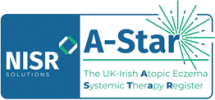
The Irish Atopic Eczema Systemic Therapy Register (ASTAR)
National and International Skin Registry Solutions (NISR) CLG
2022
The Irish Atopic Eczema Systemic Therapy Register (ASTAR) is a multicentre, prospective, observational clinical registry of paediatric and adult patients on systemic immuno-modulatory therapies. The primary objective is:
to establish the short- and long-term effectiveness of systemic immune-modulatory therapies in adults and children.
Secondary objectives include clinical data collection to:
- assess the short- and long-term safety (pharmacovigilance) of atopic eczema therapies, for instance with regard to malignancy risk, serious infections and cardiac and CNS abnormalities.
- establish a collection of health economic data for cost effectiveness research.
National and the study duration is ongoing.
ASTAR is an observational study that aims to collect data on children (no lower age cut off) and adults with atopic eczema, Starting on or switching to another systemic immuno-modulatory therapy (e.g. ciclosporin, azathioprine, methotrexate or biologic treatments). The study aims to monitor patients for at least 12 months but if possible for 10 years. The study is observational and does not involve a study specific intervention. Patient contact will be involved to take explicit consent for participation.
During the observation period, participants will be assessed on a regular (3-6 monthly basis) to collect data on disease severity and other clinical outcomes (such as quality of life), adverse events, reasons for potential changes in therapy and key healthcare resource use (e.g. hospitalisations, specialist and GP visits, and drug use). The latter will form part of the health economic feasibility assessment, which will also examine the potential use of HES and CPRD data for health economic evaluation purposes. The study outcomes are based on the results of a recent international consensus exercise – TREatment of severe Atopic eczema Taskforce (TREAT).
The first study visit occurs at enrolment (baseline visit, V1). V2 and V3 will be scheduled for 4 weeks and 16 weeks and three-monthly thereafter while on systemic therapy. After systemic treatment cessation, patients will be seen at 6-monthly intervals.
Key users of this data collection include; clinical teams, government agencies, health boards, hospitals, health care professionals, approved researchers and policy makers, (e.g., EMA), and the HSE.
ASTAR collects information on the following:
- Study enrolment:
- Consent, Inclusion/ Exclusion Criteria, Diagnostic Criteria,
- Baseline data:
- Demographics, Eczema Diagnosis, Past eczema treatment, Hospitalisations, Current eczema treatment, Allergic Comorbidities and other Comorbidities, Family History, Current concomitant medication, General Eczema Questions, Baseline Skin Examination, severity Assessment, VIGA- ADTM Scale, Patient reported outcomes, General Quality of life, Skin Specific Quality of Life Score, Asthma Control Questionnaire, Investigations performed, Imaging at Baseline, Baseline Management, Bio- Material Donation,
- Encounter and follow-up management.
- Updated variables of baseline data.
A list of collected variables is available upon request.
There is no national-level identifier however each patient enrolled is assigned their own unique registry I.D.
The ASTAR data set collects data relating to sex, country of birth, educational level and ethnicity.
Enrolment in the registry is subject to a process of gaining informed explicit consent from patients or their parents or carer (if under 18). Participation is voluntary. The data is then collected from the patients charts after their standard clinic visits and entered onto the registry platform.
Data is collected from patient medical charts and input into a secure internet-based computer database. Data collection is undertaken by EB registry data collectors.
Data is collected on a continual basis throughout the year and EB data collectors collect data on an encounter basis.
N/A
200 - 300
This data will be published annually via annual reports.
Summary data is published in the Annual Report. The ASTAR clinical team can request read only access to their centre’s patient data. Researchers can request access to de-identified data by submitting an ASTAR Data Application Form.
Each application is reviewed by the ASTAR Scientific Committee and must be approved prior to the release of any data.
Please direct any emails to: ASTAR.Ireland@nisrsolutions.com
No
The registry is accessible to permitted users only through secure internet access.